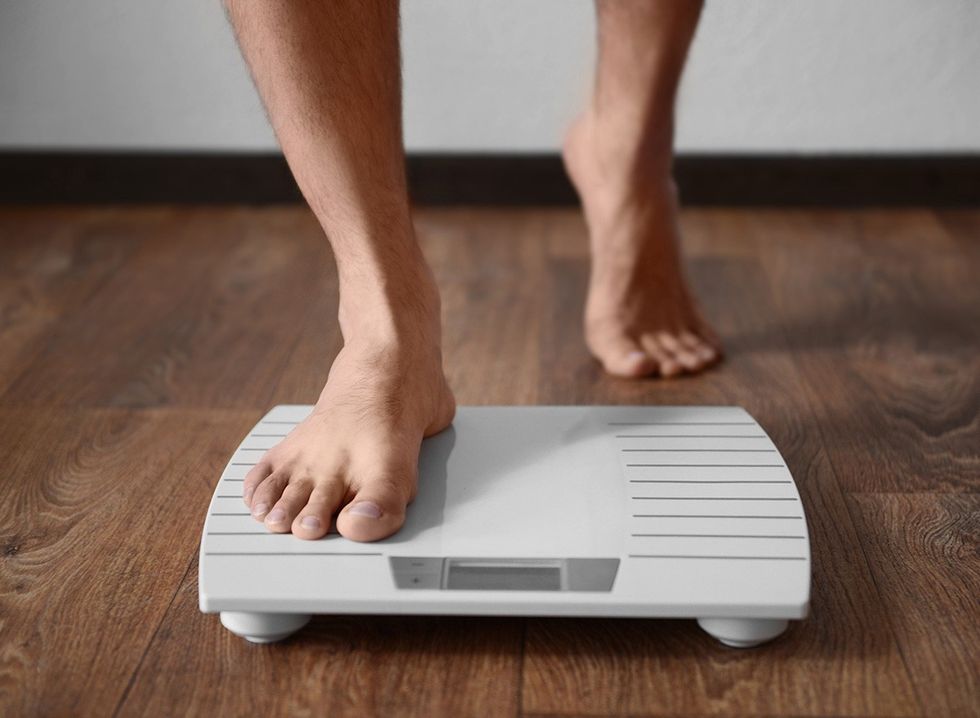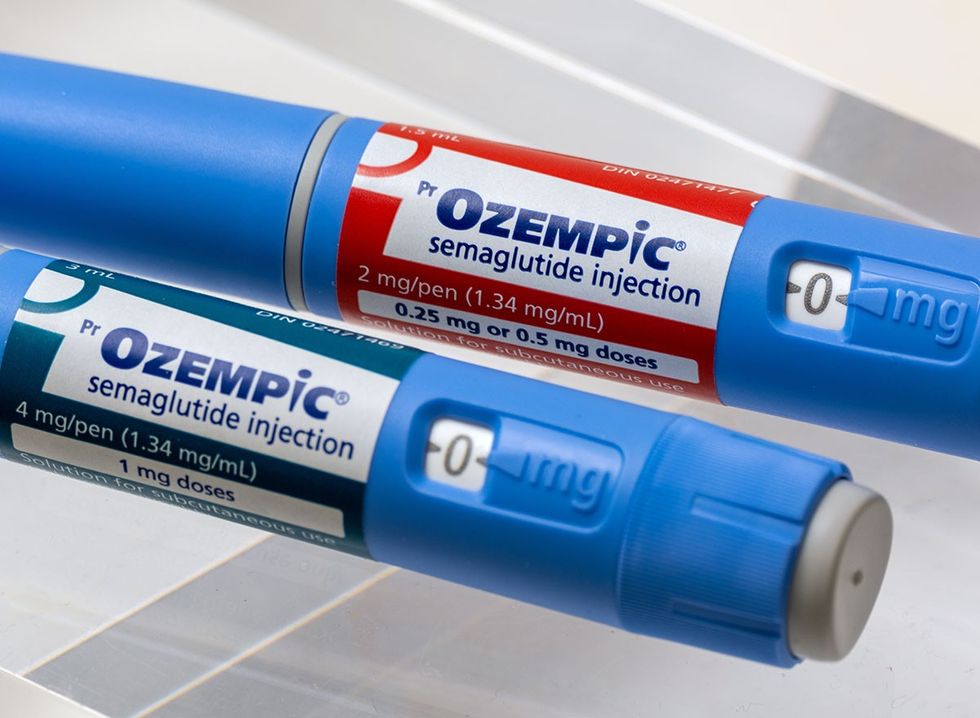Do you want to burn fat without having to go on a weight loss drug? According to an expert, there are some foods you can eat to activate the GLP-1 hormone without a jab. Christine Stines is a fat loss coach who helps “women balance blood sugar & burn fat with the help of natural supplements and fat loss plan,” she writes in her Instagram bio. In a new social media post, she unveils a list of fat-burning foods that work similarly to Ozempic. “I don’t know who needs to hear this but…You can get the same effects as Ozempic by eating these foods before meals,” she writes.
Balancing Your Gut Naturally Boosts GLP-1 Hormones
She starts by revealing one of the keys to naturally boosting your GLP-1 hormones, “that’s what's in those weight loss shots,” What is it? a “balanced gut,” she reveals.
RELATED:20 Things You Need to Know About Ozempic and Weight Loss
Here’s How It Works
“GLP 1 is created in the gut and an imbalance means you're doing to produce less of it. Why do we want to produce GLP-1? It “increases sensitivity to insulin, regulates blood sugar levels, makes you feel full, reduces your cravings, reduces your appetite its even been shown to protect your heart,” she says. “All things that are very helpful if you are trying to lose weight.”
Incorporate Probiotic and Prebiotic Food Into Your Diet
The way to do this is “incorporating pre and pro-biotic foods,” she reveals. “Especially eating them before your regular meals can help with the gut microbiome,” she says. She goes onto reveal the prebiotic or probiotic foods that will help trigger the GLP-1 hormone.
Prebiotic Foods: Garlic
 Shutterstock
ShutterstockGarlic might be stinky but it’s great for your gut. It contains inulin and fructooligosaccharides, which promote the growth of beneficial gut bacteria. It is also low in calories (just 4.5 calories per clove) and is easy to incorporate into your diet. It can be consumed raw, roasted, or added to various dishes for flavor.
Prebiotic Foods: Onions
 Shutterstock
ShutterstockOnions are another gut-balancing veggie with a pungent smell and taste. They are rich in inulin and fructooligosaccharides, which support digestive health. They are also low in calories, with an entire medium onion containing just 44. They are also versatile. Add them raw to your salad, cook with them, or use them as a flavor enhancer.
RELATED:8 High-Protein Foods with Nearly Zero Calories That Melt Fat
Prebiotic Foods: Asparagus
 Shutterstock
ShutterstockAsparagus is another veggie you shouldn’t sleep on for fat-burning. According to research, it is a good source of inulin, promoting the growth of beneficial gut bacteria. It is also low in calories, with one cup (134g) of raw asparagus just 27 calories. You can eat it raw, but it tastes better cooked – steamed, grilled, roasted, or sauteed.
Prebiotic Foods: Leeks
 Shutterstock
ShutterstockLeeks contain inulin and are part of the same family as onions and garlic, offering similar prebiotic benefits. One leek (89g) contains just 54 calories. How can you eat them? Add them to soups or stews, or sautée them as a side dish/
Prebiotic Foods: Chicory Root

Shutterstock
Chicory root is another root veggie that is high in inulin. Sometimes used as a coffee substitute or additive, it contains about 72 calories per 100g. How can you eat it? Drink it as tea, add it to coffee, or use it in cooking as a flavor enhancer.
Prebiotic Foods: Unripe Bananas
 Shutterstock
ShutterstockUnripe bananas may not taste great, but they contain resistant starch, which acts as a prebiotic. The best way to consume it is by adding it to a smoothie, so you can avoid the bitter taste. One medium unripe banana (118g) has about 105 calories.
Prebiotic Foods: Legumes (Lentils, Chickpeas)
 Shutterstock
ShutterstockLegumes, including lentils and chickpeas, are another great fat-burning food. The fibrous veggies are rich in galactooligosaccharides, promoting gut health. One cup (198g) of cooked lentils contains about 230 calories and can be used in soups, salads, or as a side dish. Chickpeas are great for tossing in salads or mashing into a hummus dip.
Prebiotic Foods: Oats
 Shutterstock
ShutterstockThere are many reasons to eat oats, and fat-burning is one of them. They contain beta-glucan, a prebiotic fiber that supports digestive health. While one cup (81g) of dry oats provides about 307 calories, it is high in fiber and keeps you full. A great way to eat it is as oatmeal or overnight oats. You can also add to smoothies or baked goods.
RELATED:12-3-30 Walking Method: 20 Proven Tips to Lose Weight Faster
Prebiotic Foods: Flaxseeds
 Shutterstock
ShutterstockFlaxseeds are rich in lignans and fiber, which support gut health. One tablespoon (10g) of ground flaxseeds contains about 55 calories. You can add flax seeds to smoothies, yogurt, or baked goods.
Prebiotic Foods: Berries (Blueberries, Strawberries)
 Shutterstock
ShutterstockBerries are a sweet and tasty way to burn fat. Blueberries and strawberries contain polyphenols that act as prebiotics, revving up your fat-burning mechanism. One cup (148g) of blueberries has 84 calories, and one cup of strawberries has 49.
Probiotic Foods: Kefir Greek Yogurt
 Shutterstock
ShutterstockThe first item on her probiotic list? Kefir Greek yogurt: The drink is rich in probiotics and protein – and it’s delicious. One cup (245g) contains about 150 calories. You can drink it out of the bottle or add it to smoothies.
Probiotic Foods: Kimchi
 Shutterstock
ShutterstockKimchi, a fermented Korean dish made out of cabbage or radish, is rich in probiotics and vitamins. One cup (150g) of kimchi contains about 23 calories and is usually eaten as a side dish or as a topping for sandwiches and also added to stir-fries.
Probiotic Foods: Sauerkraut
 Shutterstock
ShutterstockSauerkraut, fermented cabbage, is also rich in probiotics and vitamin C. One cup (142g) of sauerkraut provides about 27 calories. Some people eat it as a side dish, while others add it to hot dogs, sausages, or other foods.
Probiotic Foods: Kombucha
 Shutterstock
ShutterstockKombucha, a popular fermented tea beverage, is packed with probiotics and antioxidants with gut-balancing benefits. While exact numbers depend on the brand, one cup (240ml) of kombucha typically contains 30-50 calories and can be consumed as a drink straight out of the bottle.
Probiotic Foods: Miso
 Shutterstock
ShutterstockMiso, fermented soybean paste, is rich in probiotics and protein. One tablespoon (18g) of miso contains about 30 calories. It is a tasty and gut-boosting ingredient for soups, marinades, and dressings.
Probiotic Foods: Tempeh
 Shutterstock
ShutterstockTempeh, an alternative to tofu, is a fermented soybean product high in probiotics and protein. A 3-ounce (84g) serving of tempeh contains about 160 calories. It’s incredibly versatile, as it can be grilled, baked, or used as a meat substitute.
Probiotic Foods: Fermented Cheese (e.g., Gouda, Cheddar)
 Shutterstock
ShutterstockFermented cheeses, including Gouda and Cheddar, also contain probiotics and are rich in calcium. One ounce (28g) of cheddar cheese provides about 114 calories. Eat it as a snack or add it to various dishes, including eggs.
Probiotic Foods: Pickles (Fermented)
 Shutterstock
ShutterstockPickles, a popular fermented food, contain probiotics and are low in calories. One large pickle (135g) contains about 16 calories. Eat a pickle spear or add slices to sandwiches and burgers. And if you enjoyed this article, take advantage of these 15 Quick Ways to Lose Body Fat Percentage in a Week.














 The Power of AccountabilityShutterstock
The Power of AccountabilityShutterstock What Happens to Your Body When You Stop Eating SnacksShutterstock
What Happens to Your Body When You Stop Eating SnacksShutterstock Shutterstock
Shutterstock Shutterstock
Shutterstock Shutterstock
Shutterstock What To Do InsteadShutterstock
What To Do InsteadShutterstock Shutterstock
Shutterstock Shutterstock
Shutterstock Shutterstock
Shutterstock Shutterstock
Shutterstock What to Eat in a Restaurant for Fat LossShutterstock
What to Eat in a Restaurant for Fat LossShutterstock
 Shutterstock
Shutterstock The Long-Term PerspectiveShutterstock
The Long-Term PerspectiveShutterstock Listen to Your BodyShutterstock
Listen to Your BodyShutterstock Shutterstock
Shutterstock Chia Seeds: The Ultimate Appetite ControllerShutterstock
Chia Seeds: The Ultimate Appetite ControllerShutterstock 6. Whole Grains and LegumesShutterstock
6. Whole Grains and LegumesShutterstock Shutterstock
Shutterstock BerriesShutterstock
BerriesShutterstock Sweet Potato BowlShutterstock
Sweet Potato BowlShutterstock Shutterstock
Shutterstock Shutterstock
Shutterstock Shutterstock
Shutterstock
 Shutterstock
Shutterstock 44. Brussels sprouts: 43 caloriesShutterstock
44. Brussels sprouts: 43 caloriesShutterstock Shutterstock
Shutterstock 2. BisonShutterstock
2. BisonShutterstock 49. White fish (like cod): 48 caloriesShutterstock
49. White fish (like cod): 48 caloriesShutterstock Shutterstock
Shutterstock Shutterstock
Shutterstock Shutterstock
Shutterstock Shutterstock
Shutterstock Shutterstock
Shutterstock PapayaShutterstock
PapayaShutterstock You Eat Out Too MuchShutterstock
You Eat Out Too MuchShutterstock
 These Were Game ChangersShutterstock
These Were Game ChangersShutterstock Shutterstock
Shutterstock
 Shutterstock
Shutterstock
 1. Yerba Mate: Your New Morning DrinkShutterstock
1. Yerba Mate: Your New Morning DrinkShutterstock
 Shutterstock
Shutterstock
 Shutterstock
Shutterstock Shutterstock
Shutterstock Shutterstock
Shutterstock Collagen ProteinShutterstock
Collagen ProteinShutterstock Shutterstock
Shutterstock

 DehydrationShutterstock
DehydrationShutterstock Not Being Obsessed with Fast ResultsShutterstock
Not Being Obsessed with Fast ResultsShutterstock Skin ProblemsShutterstock
Skin ProblemsShutterstock Shutterstock
Shutterstock Bonus Tip: Look Out for Hidden CaloriesShutterstock
Bonus Tip: Look Out for Hidden CaloriesShutterstock Lack of SleepShutterstock
Lack of SleepShutterstock Don’t Skip BreakfastShutterstock
Don’t Skip BreakfastShutterstock Measuring Success Beyond the ScaleShutterstock
Measuring Success Beyond the ScaleShutterstock

 1. Hydrate the Right WayShutterstock
1. Hydrate the Right WayShutterstock Beware of Comparing Yourself to Online Success StoriesShutterstock
Beware of Comparing Yourself to Online Success StoriesShutterstock
 Indulge in ModerationShutterstock
Indulge in ModerationShutterstock



 Shutterstock
Shutterstock Here’s What to Do About ItShutterstock
Here’s What to Do About ItShutterstock 45. Edamame (boiled): 44 caloriesShutterstock
45. Edamame (boiled): 44 caloriesShutterstock Shutterstock
Shutterstock Shutterstock
Shutterstock Shutterstock
Shutterstock 28. PeanutsShutterstock
28. PeanutsShutterstock Worst: Processed MeatShutterstock
Worst: Processed MeatShutterstock Greek Yogurt & Cottage Cheese: Choosing the Right Fat PercentageShutterstock
Greek Yogurt & Cottage Cheese: Choosing the Right Fat PercentageShutterstock 16. TofuShutterstock
16. TofuShutterstock Shutterstock
Shutterstock Here’s How to Fix ItShutterstock
Here’s How to Fix ItShutterstock More Protein TipsShutterstock
More Protein TipsShutterstock